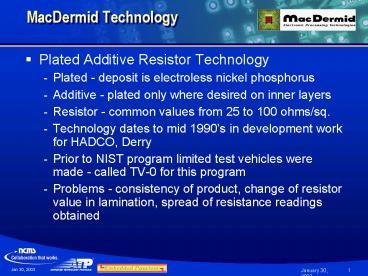MacDermid Technology - PowerPoint PPT Presentation
1 / 27
Title: MacDermid Technology
1
MacDermid Technology
- Plated Additive Resistor Technology
- Plated - deposit is electroless nickel phosphorus
- Additive - plated only where desired on inner
layers - Resistor - common values from 25 to 100 ohms/sq.
- Technology dates to mid 1990s in development
work for HADCO, Derry - Prior to NIST program limited test vehicles were
made - called TV-0 for this program - Problems - consistency of product, change of
resistor value in lamination, spread of
resistance readings obtained
2
Cross Section Diagram
MacDermid Plated Additive Resistors
3
M-Pass? Plated Resistor Technology
- Type
- Resistance Range
- Process
- Thin-Film Resistive Metal(modified Ni/P)
- 25 - 100 ohm/square
- Selective/Additive Electroless Deposition
Technique
MacDermid Resistor
4
Current State of Technology
- Applications
- Large Number of Similar Value Resistors -
Termination Resistors - ex High Speed Digital, Fiber Optic Interface,
Large Computational Requirements - Existing Technology
- Electroplated Nickel/Phosphorus on Copper Foil
- Subtractive Process Technology
- Nickel Under All Copper Circuitry (High
Frequency Applications?) - PTF Type Compositions
5
Fabrication Process Sequence
- Layer Preclean
- Apply Layer Resist
- Image
- Develop/Etch/Strip
- AOI
- Clean/Condition Layers
- Catalyze Surface
- Apply Plating Resist
- Image/Develop
- Accelerate Exposed Catalyst
- Plate Resistor Metal
- Strip Resist
- Laser Trim (if Required)
- Coat Resistor Areas
- Apply Oxide Alternative
- Laminate Multilayer Board
6
M-Pass? Process Sequence
Clean/Condition Layers Catalyze Surface Apply
Plating Resist Image/Develop Accelerate Exposed
Catalyst Plate Resistor Metal Strip Resist Laser
Trim (if Required) Coat Resistor Areas
7
M-Pass? Process Sequence
Clean/Condition Layers Catalyze Surface Apply
Plating Resist Image/Develop Accelerate Exposed
Catalyst Plate Resistor Metal Strip Resist Laser
Trim (if Required) Coat Resistor Areas
8
M-Pass? Process Sequence
Clean/Condition Layers Catalyze Surface Apply
Plating Resist Image/Develop Accelerate Exposed
Catalyst Plate Resistor Metal Strip Resist Laser
Trim (if Required) Coat Resistor Areas
9
M-Pass? Process Sequence
Clean/Condition Layers Catalyze Surface Apply
Plating Resist Image/Develop Accelerate Exposed
Catalyst Plate Resistor Metal Strip Resist Laser
Trim (if Required) Coat Resistor Areas
10
M-Pass? Process Sequence
Clean/Condition Layers Catalyze Surface Apply
Plating Resist Image/Develop Accelerate Exposed
Catalyst Plate Resistor Metal Strip Resist Laser
Trim (if Required) Coat Resistor Areas
Typical L-cut in embedded resistor. Trim was
made in automated mode to 0.3 tolerance without
damaging the underlying substrate.
11
M-Pass? Process Sequence
Clean/Condition Layers Catalyze Surface Apply
Plating Resist Image/Develop Accelerate Exposed
Catalyst Plate Resistor Metal Strip Resist Laser
Trim (if Required) Coat Resistor Areas
12
AEPT TV1-R Test Vehicle
Test Vehicle Constructed at HADCO Tech Center in
Salem, NH. (Three times)
13
AEPT Test Vehicle Results
14
MacDermid Experience from TV-1
- Materials Compatibility
- Dry Film Used
- Developer Used for Imaging
- Catalyst Activity and Acceleration Sequence
- Dry Film Thickness and Application Method
- Dependent on Copper - 1.0 or 0.5 Ounce
- Vacuum or Wet Lamination
- Change in Resistance after Lamination
- Composition dependent
- Hard to anticipate with TV-1
- M-Pass Resistors trim easily to value
15
MacDermid Experience from TV-1
- Keep scrap embedded resistor boards - there is
some use for them - Laser trim development
- Inkjet trim downward development
- Lamination studies
- Cover Coat studies
16
MAC-2R Test Vehicle
- 12 x 12 format
- Individual Resistors Routed to Periphery
- 11 x 11 cap sheet laminated
17
MAC-2R Test Vehicle
18
M-Pass? Resistance Variation
19
M-Pass? Resistance Variation
20
Capability to Trim M-Pass Resistors
21
Capability to Laminate M-Pass Resistors
22
M-Pass? Values - Post Lamination
23
M-Pass? Embedded Resistor Technology
- Selective Application - Lower Process Costs
- Completely Create Resistors at Board Fabrication
Shop - No Selling Laminate - Use Conventional PWB Processes - Laser Trim
and/or Ink Jet Trim if Required - Dwell Time Variation Allows Multiple Resistor
Values per Layer (with Multiple Imaging Steps)
24
Selective Inkjet Trimming Resistor Value Down
Courtesy of MicroFab - IPC Paper
25
MacDermid Experience afterTV-2 and Nortel
Emulator
- Wide range of substrates can be used for M-Pass
resistors - Regular FR-4
- High Temperature Epoxy
- Flexible circuits
- Low dielectric constant materials
- M-Pass Process continues to produce useable parts
quickly - More development work needed to understand small
resistor value changes upon lamination
26
M-Pass? Development Status
- Deposition Process Routinely Operational in
MacDermid Pilot Laboratory - Hundreds of NIST/AEPT Test Parts Fabricated at
Sanmina and Merix - Current Lower Size Limit - 250 Microns on 0.5 oz.
Copper Foil and Conventional Dry Film - Resistance Demonstrated - 100 Ohms/Square or Less
- Demonstrated Attractive Laser Trim Properties
27
M-Pass? Development Plan
- Make Process More Consistent
- Resistor value variability lt 5 (1 sigma)
- Demonstrate Chemical Consistency in Production
Environment - Demonstrate Higher Resistor Values (Ohms/Square)
on Production Designs - Solicit Partners for Additional Fabricator
Testing and End-User Evaluations































